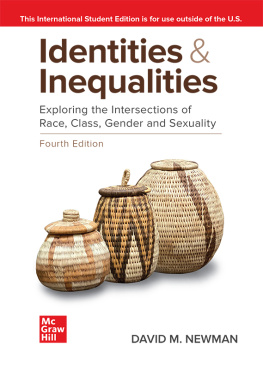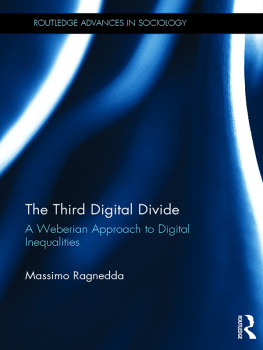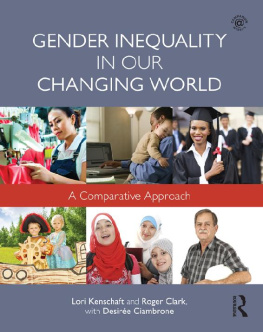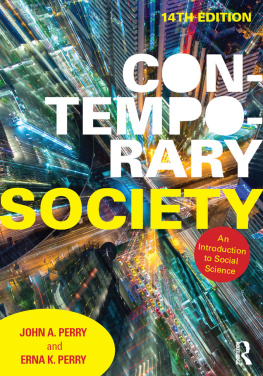FIFTH EDITION
Inequality and Stratification
Race, Class, and Gender
ROBERT A. ROTHMAN
Professor Emeritus
University of Delaware
First published 2005, 2002, 1999, 1993, 1978 by Pearson Education, Inc.
Published 2016 by Routledge
2 Park Square, Milton Park, Abingdon, Oxon OX14 4RN
711 Third Avenue, New York, NY 10017
Routledge is an imprint of the Taylor & Francis Group, an informa business
Copyright 2005, 2002, 1999, 1993, 1978 Taylor & Francis. All rights reserved .
All rights reserved. No part of this book may be reprinted or reproduced or utilised in any form or by any electronic, mechanical, or other means, now known or hereafter invented, including photocopying and recording, or in any information storage or retrieval system, without permission in writing from the publishers.
Notice:
Product or corporate names may be trademarks or registered trademarks, and are used only for identification and explanation without intent to infringe.
Credits and acknowledgments borrowed from other sources and reproduced, with permission, in this textbook appear on appropriate page within text.
ISBN: 9780131849686 (pbk)
Library of Congress Cataloging-in-Publication Data
Rothman, Robert A., (date)
[Inequality and stratification]
Inequality & stratification : race, class, and gender / Robert A. Rothman.5th ed.
p. cm.
Rev. ed. of: Inequality and stratification. 4th ed. c2002.
Includes bibliographical references and indexes.
ISBN 0-13-184968-9
1. United StatesSocial conditions. 2. EqualityUnited States. 3. Social structureUnited States. 4. Social classesUnited States. 5. Social statusUnited States. 6. MinoritiesUnited States. I. Title.
HN57.R577 2005
305.0973dc22 |
2004011166 |
To Nancy: For Everything
Contents
PART I
THE NATURE OF INEQUALITY
AND STRATIFICATION
CHAPTER ONE
Inequality and Social Stratification
CHAPTER TWO
Theoretical Approaches to Social Stratification
PART II
STRATIFICATION IN INDUSTRIAL SOCIETIES
CHAPTER THREE
Industrial Class Systems
CHAPTER FOUR
Institutionalizing and Legitimizing Stratification
PART III
PATTERNS OF INEQUALITY
CHAPTER FIVE
The Dynamics of Economic Inequality
CHAPTER SIX
Social Evaluations and Social Relations
CHAPTER SEVEN
The Shape of Political Power and Influence
PART IV
EXPERIENCING SOCIAL STRATIFICATION
CHAPTER EIGHT
Class, Race, Gender, and Life Chances
CHAPTER NINE
Class and Lifestyles
CHAPTER TEN
Class Consciousness
PART V
INHERITANCE AND MOBILITY
CHAPTER ELEVEN
Patterns of Social Mobility
The dawn of the twenty-first century was typically greeted with fireworks and great fanfare around the world, but that optimism could not be sustained much past January 1, 2000. A series of catastrophic events conspired to alter the face of the nation and the world. Among the most spectacular were the terrorist attacks in New York City and Washington, D.C., the collapse of corporate giant Enron, the failure of countless dot.com companies, a lagging stock market, and the war in Iraq. These events have had a dramatic impact on nations and their peoplescompanies have floundered, jobs have been lost, and retirement savings depleted.
This edition considers the implications of twenty-first century events. It also incorporates up-to-date information and research in keeping with the expansion and elaboration of the discipline. Importantly, it benefits from access to data from the 2000 census. Although the American experience remains the central emphasis of this work, the scope has been broadened to include more attention to global inequality and social stratification.
The basic format introduced in earlier editions has been retained.. However, the approach is flexible enough to allow faculty to reorder the chapters to fit their personal styles and preferences.
This edition, like earlier ones, is written with the undergraduate student in mind. It is intended to provide the fundamentals of social stratification for undergraduates in a concise and readable format. Key Concepts are highlighted with bold type in the text and listed at the end of chapters to facilitate review. Consequently, it may be used in different ways, as a basic text for stratification courses, or in newer sociology courses that focus on the intersection of class, race, and gender courses in stratification, or as one component of courses such as introduction to sociology, social problems, race and minorities, or gender studies. The format makes it convenient to combine it with any of several useful anthologies.
Any book that attempts to lay out the fundamentals of an area as broad and complex as stratification cannot elaborate all the areas of debate and controversy. Therefore, more advanced students are directed to the material contained in footnotes and annotated Suggested Reading sections for the resources needed to explore these issues in more depth and detail. And, consistent with the emphasis of the digital revolution, a listing of useful web sites can be found at the end of each chapter.
I would like to extend my thanks to the following people who commented on earlier editions of this work: Glenna Colclough, University of AlabamaHuntsville; Joel Franks, San Jose State University; Tracy E. Ore, Saint Cloud State University; Myron Orleans, California State UniversityFullerton; and Nancy Horak Randall, Wingate University.
Robert A. Rothman
Industrial societies are distinguished by several prominent social divisionssocial classes based on position in the economic system of production and distribution, sex and gender, and racial and ethnic categories. Many of the most significant rewards and advantages available to people are shaped by these three factors. The consequences of class, race or ethnicity, and gender are most pronounced in areas such as the distribution of earnings and wealth, judgments and evaluations of social prestige, access to political power, and life chances such as the risk of illness and access to health care, crime and justice, and educational opportunities. The system of classes, races, ethnic groups, and genders and the distribution of inequalities are supported and maintained by the culture and social structure of the country in which they exist. reviews the major theoretical conceptualizations and interpretations of the origins of industrial social systems that dominate current theory and research.
The scope of inequality in the contemporary world is obvious. Discrepanciessometimes vast discrepanciesin wealth, material possessions, power and authority, prestige, and access to education, health care, and simple creature comforts dominate the social life of societies. At the extremes are the homeless and the super-rich, the esteemed and the degraded, the powerful and the powerless, and many levels between them. There are many forms of inequality, but since the nineteenth century, sociologists have tended to focus on three major formseconomic, social, and politicalan analytic practice first suggested by the pioneering German sociologist Max Weber.
Economic Inequalities
Disparities in wealth and material resources are usually the most visible form of inequality. Industrial societies contain millions of people whose daily lives are a struggle against calamity. More than 43 million Americans have no health insurance, and 8.5 million of them are children (Mills and Bhandari, 2003). One child in ten lives in poverty in major industrial nationsAustralia, Britain, Canada, Ireland, Israel, and Italy (Pear, 1996). In America, it is one child in five! Hundreds of thousands of the destitute are homeless, compelled to wander the streets and fill the shelters in New York, Los Angles, London, and Moscow. Between 900,000 and 1.4 million American children are homeless for some period in any given year (Egan, 2002).







